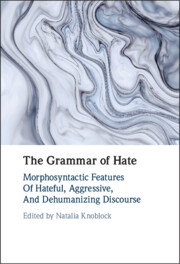Book contents
- The Grammar of Hate
- The Grammar of Hate
- Copyright page
- Contents
- Figures
- Tables
- Contributors
- Acknowledgments
- Introduction
- 1 Animacy and Countability of Slurs
- 2 Language Aggression in English Slang: The Case of the -o Suffix
- 3 Adj+ie/y Nominalizations in Contemporary English
- 4 Grammatical Gender and Offensiveness in Modern Greek Slang Vocabulary
- 5 Unseen Gender
- 6 The Neutering Neuter
- 7 Neutering Unpopular Politicians
- 8 The Power of a Pronoun
- 9 Is Play on Words Fair Play or Dirty Play?
- 10 Expressive German Adjective and Noun Compounds in Aggressive Discourse
- 11 ‘Kill the Invaders’
- 12 ‘I am no racist but …’
- 13 Homophobic Space–Times
- Index
- References
13 - Homophobic Space–Times
Lexicogrammatical and Discourse–Semantic Aspects of the Softscapes of Hate
Published online by Cambridge University Press: 30 June 2022
- The Grammar of Hate
- The Grammar of Hate
- Copyright page
- Contents
- Figures
- Tables
- Contributors
- Acknowledgments
- Introduction
- 1 Animacy and Countability of Slurs
- 2 Language Aggression in English Slang: The Case of the -o Suffix
- 3 Adj+ie/y Nominalizations in Contemporary English
- 4 Grammatical Gender and Offensiveness in Modern Greek Slang Vocabulary
- 5 Unseen Gender
- 6 The Neutering Neuter
- 7 Neutering Unpopular Politicians
- 8 The Power of a Pronoun
- 9 Is Play on Words Fair Play or Dirty Play?
- 10 Expressive German Adjective and Noun Compounds in Aggressive Discourse
- 11 ‘Kill the Invaders’
- 12 ‘I am no racist but …’
- 13 Homophobic Space–Times
- Index
- References
Summary
This chapter explores how speakers use MOOD^RESIDUE clause features and discourse–semantic resources to configure space-times homophobically, focusing on mass-media reported statements from Wyoming (USA) residents in response to the 2005 release of Brokeback Mountain. Using Systemic–Functional grammatical analysis, both interpersonal and representational lexicogrammatical features are examined, identifying: who is ‘in’ the lexicogrammatical/semantic space (speaker, addressee, non–interactants); speech function (proposition/proposal) and the interlocutors’ assigned roles (giving/receiving, offering/accepting, demanding/giving); clause participants’ location within free, bound, and embedded clauses; and clause participants– semantic content, querying the extent to which they index normative gender–sexuality or non-normative gender–sexuality. Mapping these features onto the MOOD^RESIDUE structure reveals how speakers seek to delimit the possibilities of negotiating or contesting their configurations of space and time by locating homophobic ideations within bound and embedded clauses, with an additional preference of placing such ideations with the Residue, thereby further curtailing negotiability.
- Type
- Chapter
- Information
- The Grammar of HateMorphosyntactic Features of Hateful, Aggressive, and Dehumanizing Discourse, pp. 262 - 287Publisher: Cambridge University PressPrint publication year: 2022



